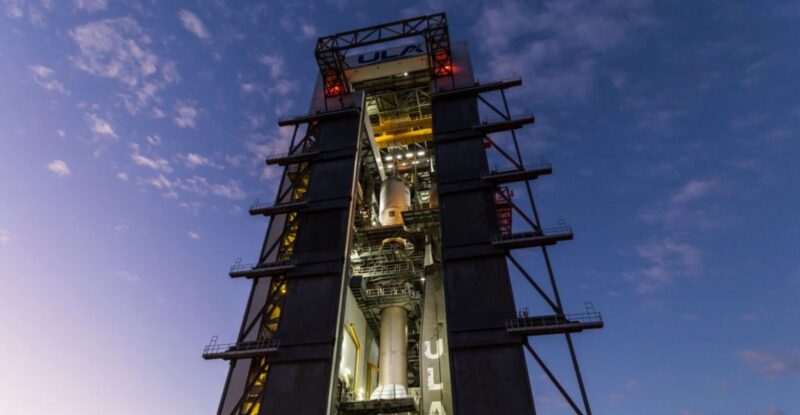Viasat is poised to soon launch its much-anticipated ViaSat-3 Flight 2 (VS-3 F2) satellite aboard a United Launch Alliance Atlas V 551 rocket from Cape Canaveral Space Force Station in Florida.
Once VS-3 F2 is online — around “mid- to end of Q1” calendar year 2026 — and Viasat starts bringing up its services, the Ka-band geostationary satellite is expected to more than double the bandwidth capacity of the firm’s entire existing fleet, Don Buchman, vice president and general manager of Viasat’s Commercial Aviation business told Runway Girl Network.
It will initially support both aviation and residential markets in the Americas.
According to United Launch Alliance (ULA), the spacecraft has successfully completed standalone launch site testing, been mated to the launch vehicle payload adapter, and has now been encapsulated in the payload fairing in preparation to join its Atlas V rocket later this week.
ULA said:
The launch of a United Launch Alliance (ULA) Atlas V 551 rocket carrying the ViaSat-3 Flight 2 (F2) mission for Viasat is planned for no earlier than Monday, Nov. 3, 2025, pending range approval.
The launch is scheduled for 10:36 p.m. EST at the opening of a 44-minute window, from Space Launch Complex-41 at Cape Canaveral Space Force Station, Florida.
The VS-3 constellation is comprised of three Ka-band GEO satellites, each designed to be capable of rapidly shifting capacity throughout its coverage area to deliver bandwidth where and when it’s needed most. The first satellite, VS-3 F1, suffered a reflector deployment problem which dramatically reduced its capacity to less than 10%. Thereafter, Viasat engaged in a lot of the root cause analysis, simulations and physical testing of the VS-3 F2 satellite to remedy any potential weakness.
“The design was strengthened throughout,” said Buchman.
He told Runway Girl Network Viasat has “very high confidence” that any issues have been addressed.
Despite the VS-3 F1 anomaly, Viasat has put the remaining capacity to good use in the aviation market, with passenger surveys showing the satellite is supporting a “phenomenal quality” of service on the southwest U.S.-Hawaii routes where it is in play, Buchman said.
“It’s a game changer,” he said, and airlines can expect the same when VS-3 F2 is in service.
Initially, with VS-3 F2, “residential will be served, and aero; those are kind of your two big markets,” he said. Thereafter, other markets — maritime, energy and fixed enterprise — are expected to be addressed.
Living in a rural area, your author once explored Viasat’s residential plans, but when it came time to buy, the plans were no longer on offer in my area. That’s because, after the VS-3 F1 anomaly, Viasat focused its F1 capacity on aviation. “We don’t oversell,” Buchman noted, so VS-3 F2 will “unlock that problem you ran into. So, we’ll start that engine back up.”
He noted:
What’s really important is the flexibility it brings. When you think of traditional satellites it’s essentially fixed capacity on the ground with not a lot of flexibility… you had to know where your demand is.
With ViaSat-3, the capacity follows the demand.
We’ve seen really good examples in the North Atlantic, so when you go from U.S. to Europe, you get weather patterns and wind patterns and the entire flight patterns will shift hundreds of miles north or south and so that shifts away from where the density of your capacity is… all the aircraft will be now outside of your densest areas, and your capacity doesn’t follow the demand. And so, with ViaSat-3, when we talk about flexibility, that’s what we’re talking about is it follows the demand, instead of having to predict where the demand is at.
And so that’s the flexibility that we’ve really seen play out just with a limited mission with F1 that we redeployed. So, we’re probably 16 months into launching airlines on that, and it’s performing phenomenally.
With ViaSat-3 satellites offering flexible capacity — and the forthcoming VS-3 F3 satellite expected to do the same for Asia-Pacific routes — Viasat’s older static assets become more valuable, Buchman suggested. The ViaSat-1 satellite, for instance, has fixed beams over the eastern third of the United States and some western states. “So that will allow us to, with this flexible capacity, get the best use of both, such that we can actually amplify the production of those older assets when they’re coupled with these new assets, like ViaSat-3 coming in.”
In the United States, Viasat counts American Airlines, Delta Air Lines, JetBlue Airways and Southwest Airlines among its inflight connectivity customers. United Airlines is also a customer, though it is in the process of fitting SpaceX’s Starlink LEO satcom solution to its fleet. VS-3 F2 provides an opportunity for Viasat to expand within its base and add more customers, especially as operators adopt the free Wi-Fi model, and as that adoption spreads globally, Buchman told RGN.
The high-capacity asset will also help airlines to unlock more operational benefits via the cabin connectivity pipe. “I think you’ll start seeing a lot more data being driven by the crew and in the aircraft itself,” Buchman said.
In the meantime, there’s great excitement at Viasat’s offices in Carlsbad, California as VS-3 F2 nears its launch from Cape Canaveral.
Related Articles:
- ANA taps Viasat to power free Wi-Fi on international routes
- JetBlue to install Amara IFC on new jets under extended Viasat pact
- How Boeing Global Services is supporting Starlink installs on 787s
- Anuvu microGEO satellites now operational over the United States
- Viasat details Amara nextgen inflight connectivity strategy
- VIDEO: Delta innovates with Hughes partnership, IFEC integration
Featured image credited to United Launch Alliance












